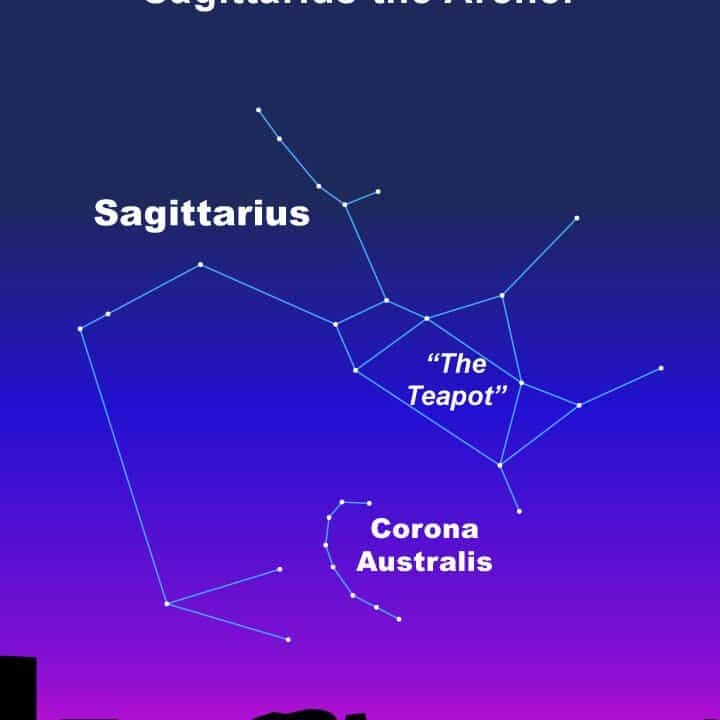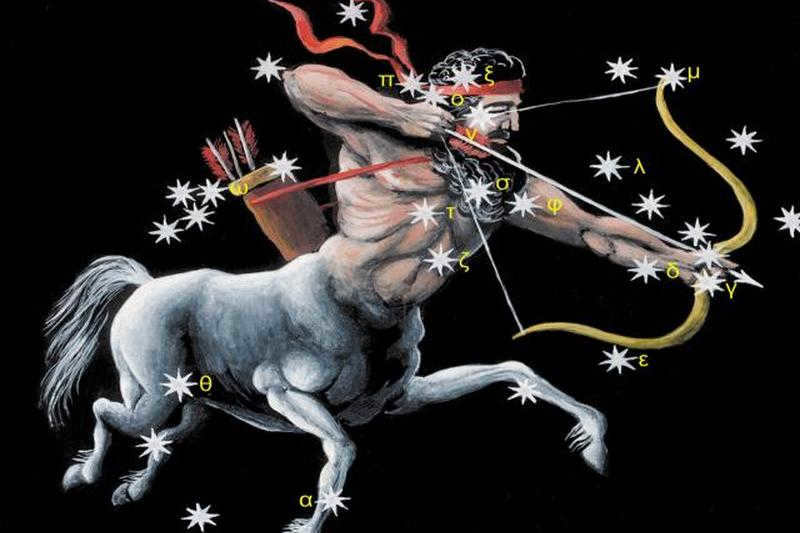
Sagittarius is positioned close to the deepest part of the Milky Way, which is where you can find the galactic center. Due to this location, it contains numerous fascinating deep space objects. In present times, modern astronomers often refer to Sagittarius as the “teapot,” but in ancient Greek and Roman mythology, it was believed to represent a centaur with an arrow pointing towards the heart of Scorpius, the Scorpion. Throughout history, the image of the archer centaur has served as the symbol for this diverse constellation and the astrological sign of Sagittarius.
Exploring the Wonders of Sagittarius
Sagittarius can be found in one of the most breathtaking regions imaginable – the heart of the Milky Way galaxy. It is easily identifiable due to its striking configuration of bright stars that resemble the shape of a teapot.
Sagittarius is home to numerous star clusters, globular clusters, nebulae, and binary stars. While some of these celestial wonders can be seen with the naked eye, to truly appreciate the hidden beauty, binoculars or a telescope are recommended. Find a secluded spot away from city lights, gaze up at the night sky, and seek out the bulge within the celestial band of the Milky Way. This marks the location of the galactic center, nestled within the boundaries of the captivating Sagittarius constellation.
Observers in the Northern Hemisphere can observe the constellation Sagittarius during the summer months from June to August, as it hovers just above the southern horizon. On the other hand, observers in the Southern Hemisphere have the advantage of viewing Sagittarius directly overhead, providing them with the best vantage point.
Regardless of your location, locating Sagittarius can be made much easier with the use of a star chart specific to your area:
- AstroViewer is a website that generates a personalized star map based on your location, and you can even download an interactive star map for reference if you don’t have internet access in your stargazing spot.
- Starmap, available on the Apple App Store, allows you to transform your smartphone into a constellation finder.
- The Skyview app enables you to simply point your iPhone towards the sky to identify stars, constellations, and even satellites.
Constellations and astrological zodiacs
In contemporary astronomy, the sky (celestial sphere), when observed from Earth, is divided into 88 regions of various sizes known as constellations. The official boundaries of these constellations were established by the International Astronomical Union (IAU) in 1930. The astrologer/astronomer Ptolemy first documented the forty-eight modern constellations in 105 AD.
The astrological zodiac is based on the changing seasons and divides the earth’s ecliptic into twelve equal parts of 30 degrees each, corresponding to the solstice and equinox days.
The zodiacal constellations are the 13 constellations that intersect the earth’s ecliptic. Among these constellations, 12 of them share the same names as the astrological zodiac signs. It’s important to note that there is a distinction between the astronomical zodiac constellations and the astrological zodiac.
- From approximately December 17 to January 20, the Earth’s Sun aligns with the constellation Sagittarius.
- From about November 22 to December 21, the Sun is in the astrological sign of Sagittarius.
However, the fact that they are not identical does not diminish the significance of constellations and their fixed stars in astrology. Constellations hold a significant place in humanity’s oldest astrological traditions, and their myths and legends have been used to define the zodiac signs.
Sagittarius constellations and beyond
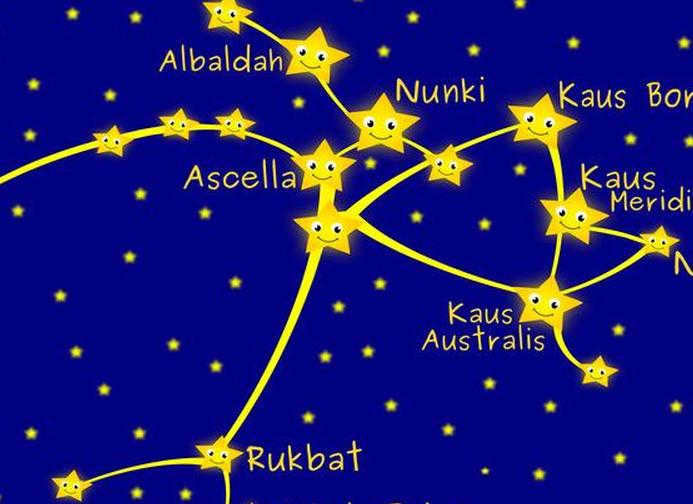
Sagittarius is linked to Jupiter, the planet of abundance, which perfectly represents the magnificence of the constellation with the same name.
The Sagittarius constellation includes:
- The cluster of stars known as the Arches
- The Five star cluster, which contains the bright pistol star
- The Sagittarius A radio source
- The Sagittarius A dwarf elliptical galaxy
- The Sagittarius A dwarf irregular galaxy
- The Barnard Galaxy
- The Bubble Nebula
- The Sagittarius Star Cloud
- The Omega Nebula
- The Lagoon Nebula
- The Triple Divided Nebula
Additionally, there are 32 confirmed exoplanets orbiting this constellation. The most prominent stars in Sagittarius create a recognizable pattern resembling a teapot. Among these stars, three are part of the archer’s bow: Kaus Borealis, Kaus Medius, and Kaus Australis.
Many astrologers utilize fixed stars to enhance their interpretations. Currently, most of the fixed stars in Sagittarius align with the astrological sign of Capricorn. Below are the astrological coordinates of the three stars located on the archer’s bow, along with some insights they offer to astrologers.
- Kaus Borealis, situated at the apex of the arc towards the northern end, is currently positioned at 6+ degrees Capricorn. Individuals with this prominent star tend to advocate for idealistic and compassionate ideas, display entrepreneurial qualities, and possess a strong sense of justice.
- Mid-Nasal Causus Medius: currently positioned at 4+ degrees Capricorn, this star is known for its association with politeness, popularity, and having a large social circle.
- Southern Onion Kaus Australis: located in the lower part of the onion, specifically at 5+ degrees Capricorn, this star is often linked to individuals possessing a calm demeanor, sharp intellect, and unwavering determination.
Among the numerous awe-inspiring celestial objects within the Sagittarius constellation, the galactic center stands out as both remarkable and of immense astrological importance.
Galactic Center: Earth’s Sun
The Moon orbits the Earth, while the Earth and other planets in the solar system orbit the Sun. The Sun, along with the entire Solar System and the Milky Way Galaxy, revolves around the galactic center. In a way, we can think of the galactic center as the sun of our Sun.
The galactic center is a massive black hole, about the size of a large star, that contains the mass of four million suns. It serves as the focal point around which the Milky Way rotates. Situated on the border of the Sagittarius and Scorpius constellations, the existence of this black hole was only confirmed by science on September 5, 2001, thanks to the findings of the Chandra X-ray Observatory.
While astronomers and other scientists refer to it as a “black hole,” astrologers perceive it from a completely different perspective. Instead of viewing it as a black hole, they see it as an immense energy zone that emits both power and light.
Expanding the boundaries of astrology
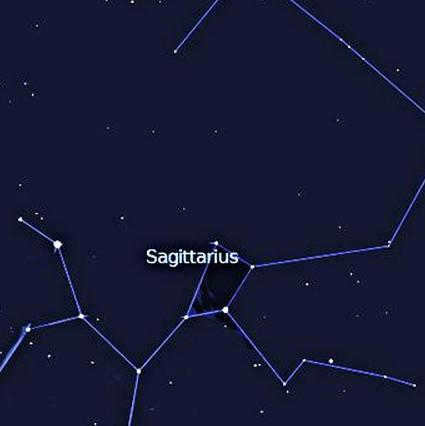
A new area of exploration and a fresh concept have emerged for astrologers with the discovery of the Galactic Center. Astrologers initially found a clue in its placement within the astrological sign of Sagittarius, which is known for its pursuit of truth, freedom, and upholding moral values. This suggests that any aspect of a person’s chart that is influenced by the galactic center is connected to these significant Sagittarius themes.
For instance, consider Bob Dillon, the honest Nobel laureate, singer, songwriter, and poet, who has Mercury, the divine messenger, positioned at 27 Gemini in opposition to the galactic center.
Informants
A research conducted by astrologer Mandy Lockey delved into the realm of “whistleblowers” positioned at 27 degrees Sagittarius. Informants undeniably bring illumination to a situation, unveiling what one cannot help but be aware of. And through their honesty, they aid in awakening the world and steering it towards a new direction.
- Karen Silkwood, who was the initial and most renowned nuclear whistleblower, had her galactic center in conjunction with her South Node in Sagittarius and opposing her North Node in Gemini.
- Julian Assange, whose narrative is still ongoing, has his galactic center opposing Venus in Gemini and forming a square with Pluto in Virgo.
- Edward Snowden, who was employed by the National Security Agency and revealed its practices, has his galactic center in conjunction with his South Node in Sagittarius and opposing the conjunction of Mars, North Node, and Sun in Gemini.
Mandy Lockey provides in-depth information on these three instances, as well as numerous other researchers she has studied. Her conclusion is that, “The prevalence of power and information theft is emerging as a prominent theme in astrological GC…” Interestingly, all of the whistleblowers mentioned in the study also experienced significant planetary transits or connections to their natal charts, specifically those linked to the galactic center during or near the significant dates of the whistleblowing events.
Research into astrology will continue, with astrologers continually adding more insights into the astrological impact of the galactic center. The complete narrative of the galactic center has yet to be fully explored.
Ancient tales and folklore

The tales surrounding the constellation of Sagittarius are a perplexing blend. Sagittarius has been portrayed in various forms in different ancient civilizations, giving rise to marvelous narratives. However, what unites all these stories about Sagittarius is its dual nature, encompassing both animal and human qualities.
- The Sumerians envisioned Sagittarius as Enkidu, a feral man nurtured by animals.
- In ancient Mesopotamia, Sagittarius was linked to Nergal, the warrior. Hammurabi described Nergal as “an unparalleled champion who brings triumph”.
- Pabilsach, the Babylonian god of war, took the form of a bull-centaur-like creature with a scorpion’s tail, wielding a bow and arrow.
In Greek mythology, Sagittarius held the following significance:
- Bellerophontes, the prince-hero of Corinth, was known for his mastery of the winged horse Pegasus and for slaying the fearsome Chimera.
- Krotus, a peaceful satyr, was considered a minor Greek god or demon. He was known for his skill in hunting on horseback and for inventing the bow. Additionally, Krotus was a talented musician and had a deep appreciation for art. It is important to note that in ancient Greece, the term “demon” referred to a spirit or being filled with knowledge.
- Chiron, a renowned healer, teacher, and mentor, was widely regarded as the wisest and most just of all centaurs. He possessed noble character, performed righteous deeds, and had divine powers.
All of these mythical figures contribute to the diverse nature of the zodiac sign Sagittarius.
The tale of Orion, Scorpio, and Sagittarius
Situated in the celestial sphere, Sagittarius can be spotted facing Orion and adjacent to Scorpius, whose arrow directs towards the star Antares, known as the “scorpion’s heart.” In this ancient legend, the formidable hunter Orion met his demise at the hands of Scorpius. In order to pay homage to their valor, Zeus decided to immortalize them by placing their constellations in the sky. However, Zeus employed his cunning and separated them by locating the constellations of Orion and Scorpio at opposite ends of the nocturnal expanse. As an added precaution, Zeus positioned the arrow of Sagittarius directly into the heart of Scorpius, as a deterrent in case Scorpius ever contemplated pursuing Orion once more.
The Symbolism of Sagittarius
Sagittarius, an astrological sign, encompasses a wide range of themes and concepts. It is often associated with activities such as hunting, sports, weapons, and military, as well as with the notion of travel. Additionally, Sagittarius is linked to concepts such as law, justice, healing, teaching, learning, theology, and philosophy. The various myths surrounding Sagittarius, from the story of the “wild man” Enkidu to the tale of the wise and nurturing Chiron, highlight humanity’s innate desire to transcend primal instincts by expanding its knowledge and understanding of the world and its universal truths.
Sagittarius is a prominent constellation situated in the southern hemisphere, neighboring the constellations Capricorn, Serpentor, Southern Crown, Scorpio, and others. Covering an area of approximately 867 square degrees, Sagittarius lies at a distance of 30,000 light years away from Earth. From December 18 to January 18, the Sun resides within Sagittarius.
This constellation, which was discovered in ancient times, is often depicted as a centaur – a mythical creature with the upper body of a man and the lower body of a horse. In the depiction, the centaur is shown drawing a bow and aiming arrows into the distance.
The constellation Sagittarius is home to several bright and large stars, including Caus Australis, Nunki, Sigma, Delta, Lambda, Phi, Pi, Askella, Caus Meridianalis, Caus Borealis, and others. Among these stars, Delta, Epsilon, and Lambda are specifically known as the archer’s bow.
One standout star in Sagittarius is Kaus Australis, which is a blue giant star and considered the brightest in the constellation. It is located 143 light-years away and shines 375 times brighter than the Sun.
Lambda, on the other hand, is an orange giant star that is 52 times brighter than the Sun. It is still in the process of forming but is currently stable.
Sigma, another notable star in Sagittarius, is a hydrogen dwarf. It is the second brightest star in the constellation and is located 228 light-years away.
Phi is a giant star that is situated 231 light-years away from us.
Delta, which represents the middle bow of Sagittarius, is a giant star with three rotating companions. It shines 1180 times brighter than the Sun.
Ross 154 is a red-hued dwarf star, situated 9.68 light-years away, making it the nearest star to our solar system.
An additional intriguing entity within the Sagittarius constellation is Sagittarius A – the epicenter of the Milky Way, which emits radio waves. Unfortunately, due to the presence of cosmic dust clouds, this object remains invisible to telescopes. It is widely believed that Sagittarius A harbors a supermassive black hole.
Typically, the Sagittarius constellation becomes visible in the sky from the latter half of February until mid-November, with the most optimal period for observations being June-July. This constellation can be observed quite distinctly in the central and southern regions of Russia.
What is the appearance of the constellation Sagittarius in the night sky?
Among the numerous constellations that adorn the night sky, only a few possess a distinctive and easily recognizable pattern. Sagittarius is one such constellation. However, its arrangement of bright stars does not resemble a bow-wielding figure, but rather takes the shape of… an ordinary teapot!
Asterism Teapot
The Asterism Teapot is a unique and one-of-a-kind teapot that stands out from the rest. It is a true masterpiece of craftsmanship and design. This teapot is adorned with a beautiful asterism pattern, which gives it a mesmerizing and magical appearance. The pattern is created by the reflection of light on the surface, creating a stunning star-shaped effect. The Asterism Teapot is not only a functional piece of kitchenware, but also a work of art that can be proudly displayed.
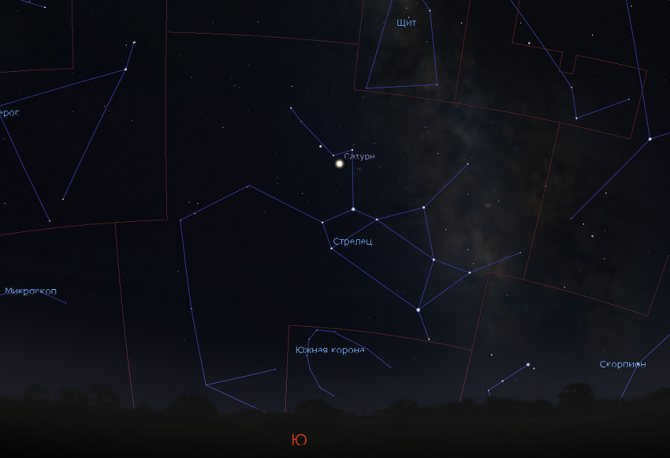
The Sagittarius constellation can be observed in the sky above Sochi, Russia, although it doesn’t fully rise due to its position in the southern hemisphere. The boundaries of the constellation are marked with a red line. Image credit: Stellarium
Take a closer look at the diagram illustrating the path of Sagittarius as it crosses the meridian in the skies of Crimea and Sochi. With a bit of imagination, one can spot not only the shape of a liquid container but also the spout, handle, and even the lid formed by the stars!
Only the spout and partly the lid of the asterism known as “Kettle” in the St. Petersburg sky are visible. Image: Stellarium
Thus, the primary figure of Sagittarius is the asterism called “Teapot”. However, in Moscow’s latitude, the “Kettle” does not rise completely. Only the spout and lid are visible above the horizon, while the tea pot and handle can be partly observed (with the exception of the star epsilon of Sagittarius, which does not rise above the horizon).
In St. Petersburg, the situation is even worse as the handle is completely invisible.
As a result, locating the constellation of Sagittarius in the sky is not an easy task for most of us!
Is it possible that it’s actually an archer?
During his time, the American writer Hans Rey took on the challenge of identifying the figures that constellations represent. The outcome of his efforts was an excellent book called “Stars. New outlines of old constellations” which has been translated into numerous languages worldwide, including Russian.
According to Rey, the constellation Sagittarius resembles a man holding a bow. Here is how he connected the stars to form the figure:
Sagittarius constellation according to G. Rey. Figure: Stellarium
It’s worth noting that in Russia, the archer’s legs are not visible, which may make the figure appear disproportionate.
The constellation Sagittarius is located partly in the Milky Way and partly in the zodiac belt. It can be observed best in the southern part of the horizon during the months of July and August. Adjacent to Sagittarius are the constellations Capricorn, Microscope, Southern Crown, Scorpius, Serpent, Shield, and Eagle. In the night sky, the constellation of Sagittarius stands out against the milky white background of the Milky Way. On a clear and moonless night, approximately 115 stars can be seen with the naked eye, although many of them are faint. Among these stars, there are only two with magnitudes of 2m and eight with magnitudes of Zm, making them the brightest stars in Sagittarius. These stars are mentally connected by lines, forming a complex configuration with fainter stars in between. Despite the intricate arrangement, it is challenging to make out the mythical centaur Chiron, who is depicted as half-man, half-horse, drawing a bowstring and aiming an arrow at Scorpius. Chiron seeks revenge for Scorpius fatally stinging the legendary hunter Orion. Behind Chiron, two wide ribbons flutter, adorned with bright stars. This is the ancient depiction of the constellation Sagittarius.
In the constellation of Sagittarius, there are numerous scattered and globular clusters of stars, most of which can be observed using binoculars. The globular clusters M 28 (NGC 6626), M 69 (NGC 6637), M 70 (NGC 6681), M 54 (NGC 6715), M 55 (NGC 6809), and M 22 (NGC 6656) offer a particularly stunning view through binoculars or a regular telescope. The last two clusters, being the brightest, are barely visible to the naked eye. The globular star cluster M 55 (NGC 6809) has an apparent stellar magnitude of 6m,4 and measures 43 light-years in diameter. Its distance from Earth is estimated to be 13,050 light-years, and it is moving away from us at a speed of 170 kilometers per second. The globular star cluster M 22 (NGC 6656) has an apparent stellar magnitude of 5m,1 and a diameter of 62 light-years. It is located at a distance of 8,200 light-years and is approaching us at a speed of 144 kilometers per second. The core of our Galaxy lies in the direction of the Sagittarius constellation. Despite its immense size, approximately 4,000 light-years in diameter, and the abundance of stars within it, the core cannot be observed even with the most advanced telescopes. This is due to the presence of numerous dark nebulae that absorb the light emitted by the core stars. However, these nebulae allow long-wave and infrared radiation from the core to pass through. In 1951, Soviet scientists A. Kaliniak, V. Krasovsky, and V. Nikonov utilized this fact when capturing infrared images of the nucleus. Our Sun is located approximately 30,000 light-years away from the galactic nucleus and orbits it at a speed of 220 kilometers per second, completing one revolution every 200 million years, which is known as a galactic or cosmic year.
According to mythology, the constellation Sagittarius is associated with the centaur Chiron. Chiron, like all centaurs, had the body of a horse from the waist down, with four strong hooves. He was known as the wisest of all the centaurs and was the teacher of many famous mythical heroes. Chiron resided in a cave hidden by an olive grove at the foot of Mount Pelion. In this cave, he would recline on laurel and myrtle branches and play the golden lyre. Through his songs, Chiron imparted wisdom to his disciples, who listened attentively. One of the topics Chiron sang about was Chaos, the eternal and infinite source of life and light that existed before everything else. From Chaos came the Earth, personified by the goddess Gaia, who provided life and strength to all living beings. Deep within the Earth was Tartarus, a dark and inaccessible abyss. Chiron also sang about Love (Eros), which Chaos gave birth to, as well as the creation of Darkness, Night, Light, Day, and the boundless blue Sky (Uranus) that stretches above the Earth. Mountains rose from the Earth and valleys spread out, leading to the vast and noisy sea. The gods, including Zeus, resided on the peaks of Mount Olympus, illuminated by eternal light. Chiron’s songs also praised the power of fire within the Earth, which gave strength to humanity through the use of metals and ores. He sang about the healing properties of herbs, the ability to predict the future, and the beauty, fearlessness, and courage of heroes. Chiron extolled the benefits of hunting and games, which made heroes invincible and rewarded them with eternal glory. He celebrated the greatness of music, which uplifted the human soul, as well as the advantages of peaceful life and hard work. Each day, Chiron shared his knowledge through song with his disciples, teaching them skills such as archery and spear-throwing. When the sun began to set, signaling the end of the day, Chiron’s disciples would go hunting in the mountains and return with their successes. They would proudly present their kills to Chiron, who praised their strength and courage. Aesculapus, one of Chiron’s disciples, discovered a herb that could cure snakebites and gathered other herbs for treating various diseases. Chiron was pleased with Aesculapus’ discovery and advised him to continue searching for medicinal herbs. Afterward, the disciples would gather firewood, build a large fire, and feast on their hunted game. Chiron would then send them to the spring to bathe before allowing them to eat. Following the meal, the disciples would engage in conversation with their wise teacher, followed by playing and singing together. As night fell, Chiron would climb a nearby hill with his lyre, accompanied by his pupils. From there, they would admire the starry sky and the moon while Chiron sang about the night. At midnight, Chiron would descend the hill and send his disciples to sleep. When the goddess of dawn, Eos, opened the gates for the sun, Chiron would awaken and go to the spring to bathe. He would blow his horn to rouse his disciples, and they would join him at the spring for a refreshing bath before returning to the cave. Chiron would then lead them on a morning walk through the forest until the sun rose in the east. Afterward, they would have breakfast and gather on a green meadow to listen to Chiron’s wise speeches. Once Chiron finished speaking, the disciples would practice various physical activities such as running, jumping, and throwing stones, arrows, and spears. This daily routine made Chiron’s disciples strong, cheerful, and happy, and their laughter filled the mountains and valleys. Chiron, being a wise centaur, knew the destinies of his pupils and trained them accordingly. One of his most notable pupils was Achilles, who would later play a crucial role in the Trojan War. Chiron fed Achilles bear brains and lion livers and taught him archery and music. Achilles grew up to be a skilled warrior, capable of performing great feats. Many of Chiron’s other centaur pupils joined Jason on his quest for the golden fleece. Aeson, Jason’s father, entrusted his son to Chiron’s care, knowing that he would be trained to become a brave and just leader. Jason spent twenty years under Chiron’s tutelage, learning not only physical skills but also the art of healing with herbs. When Jason embarked on his journey to Colchis, he and his fellow Argonauts visited Chiron, who rejoiced in seeing his students embark on such a grand adventure. They feasted together and enjoyed the music of Orpheus, who Chiron praised for his ability to bring joy and happiness through his songs. After Chiron’s death, the gods honored him by transforming him into the constellation Sagittarius, where he shines among the other constellations for his role in nurturing and teaching the most illustrious heroes of Greece, including some who were sons of Zeus.
How can I locate the Sagittarius constellation?
To spot the Sagittarius constellation, direct your gaze towards the south during the evening hours, specifically in the latter half of summer once darkness has fallen. This constellation can be found directly beneath the Summer Triangle.
In the southern region of Russia, the Sagittarius constellation rises in the southeast and sets in the southwest over the horizon. In Crimea and the Caucasus, Sagittarius can be observed from April (rising in the morning) until October (visible in the early evening).
During the month of August, the Sagittarius constellation can be seen in the Moscow sky. Image: Stellarium
Ruling Planet
Individuals belonging to this astrological sign are under the influence of Jupiter, the celestial body named after the supreme deity of ancient Rome. Intelligence, nobility, and integrity are the primary virtues that guide the universe in his grasp.
There are only a few constellations in the celestial sphere that possess a distinctive and memorable pattern. Sagittarius is among them. However, the arrangement of its brightest stars does not resemble a human figure with a bow. Instead, it somewhat resembles… a regular teapot!
Teapot with an Asterism Pattern
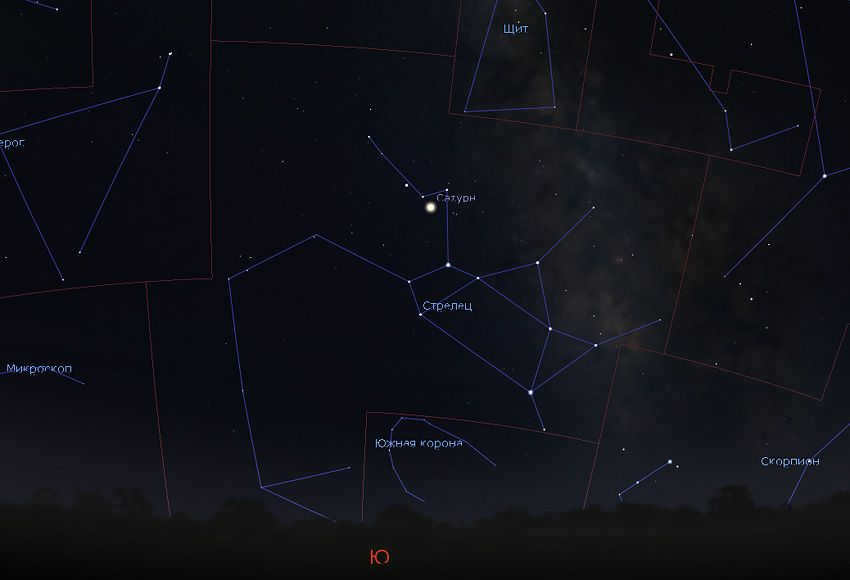
In the sky of Sochi, we can observe the Sagittarius constellation (the boundaries of the constellation are indicated by a red line). It is interesting to note that even in the southern region of Russia, Sagittarius does not fully rise. This information is based on the data provided by Stellarium.
Let’s take a closer look at the diagram depicting the position of Sagittarius as it crosses the meridian in the skies of Crimea and Sochi. It doesn’t require much imagination to see not only a liquid container but also a spout, handle, and even a lid in the arrangement of stars!
The sigma (σ) star at the bottom of the spout and the epsilon (ε) star at the bottom of the Kettle’s handle are the most luminous stars in Sagittarius, both having a magnitude of 2nd, which means they are equally bright as the stars in the Big Dipper. The remaining stars in Sagittarius are not as radiant and would be quite challenging to observe in a sky illuminated by city lights.
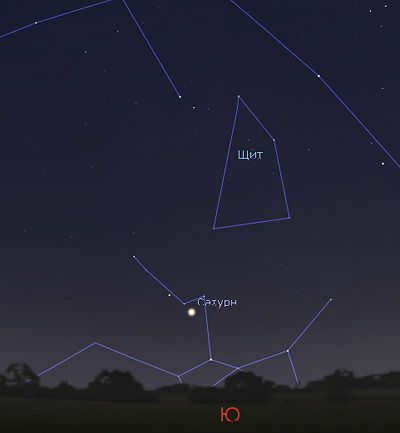
Only the spout and, to some extent, the lid of the asterism “Kettle” can be seen in the sky of St. Petersburg. Image: Stellarium
Therefore, the main feature of Sagittarius is the asterism “Teapot”. However, at the latitude of Moscow, the “Kettle” does not rise completely. Only the “spout” and the “lid” are visible above the horizon, and the tea pot and the handle can be partially observed (the star epsilon of Sagittarius does not rise above the horizon).
The situation is even worse at the latitude of St. Petersburg – the “handle” is not visible at all.
That is why it is not so easy for most of us to locate the constellation of Sagittarius in the sky!
Could it be an archer after all?
During his era, the renowned American author Hans Rey embarked on a mission to decipher the true meaning behind the constellations. The outcome of his endeavor was an exceptional book titled “Stars: New Interpretations of Ancient Constellations”, which has been translated into numerous languages, including Russian.
Ray proposed that in the Sagittarius constellation, one can perceive the silhouette of a man holding a bow. Take a closer look at how he connected the stars within this constellation:
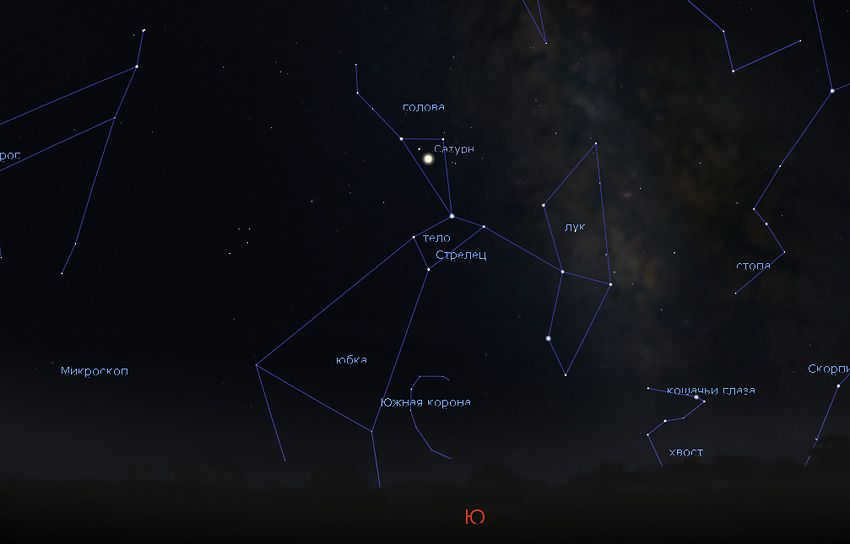
According to G. Ray, this is what the Sagittarius constellation looks like. Image source: Stellarium
It is worth mentioning that in Russia, the lower half of the archer’s body is not visible, which makes the figure appear disproportionate.
Looking for the Sagittarius Constellation?
If you want to spot the Sagittarius constellation, all you need to do is look south on a clear evening during the second half of summer. Once it’s dark outside, you’ll be able to see it shining brightly. The Sagittarius constellation can be found directly below the Summer Triangle, making it easier to locate.
In the southern part of Russia, you can see Sagittarius rising in the southeast and setting in the southwest. If you’re in Crimea or the Caucasus, you’ll have the chance to observe Sagittarius from April (when it rises in the morning) all the way until October (when it can be observed in the early evening).

In August, the constellation Sagittarius can be observed in the Moscow sky. This information is based on the data obtained from Stellarium, a software program used for astronomical observations and simulations. The constellation Sagittarius is known for its association with the Milky Way, which is a prominent feature of the night sky. The Milky Way is a vast, spiral-shaped galaxy that contains billions of stars, including our own sun. Observing Sagittarius and the Milky Way can be a fascinating experience for stargazers and astronomers alike.

The Milky Way can be seen in the constellation of Sagittarius. The photograph above, taken by Jason Gambone, shows the beauty of this celestial phenomenon.
Sagittarius is particularly interesting because it is home to the brightest parts of the Milky Way in the sky! This is not surprising, as Sagittarius is situated in the center of our galaxy where stars are densely packed. These stars form a spherical thickening known as the bulge, which gives the Milky Way its wide appearance in the sky. The Milky Way stretches across neighboring constellations such as Scorpius and Serpentor.
It is unfortunate that we are unable to see the central part of the Galaxy due to the presence of dark cosmic dust clouds. Without these clouds, the Milky Way in Sagittarius would emit a much stronger light than the full Moon in the sky. Its brightness would be sufficient to read a book even on the darkest night!
However, even in its abbreviated state, the Sagittarius region of the Milky Way is a veritable treasure trove of stunning nebulae and clusters of stars. In the southern parts of Russia, even with a small amateur telescope, one can marvel at the brilliance of M8, also known as the “Lagoon” nebula, as well as M20, referred to as the “Triple” or “Trifid” nebula, and M17, nicknamed the “Omega” nebula. In terms of luminosity, the globular cluster M22 rivals its renowned counterpart, the M13 cluster in Hercules. Additionally, the diffuse star cluster M25 and the celestial object M24, a stellar cloud within the Milky Way, are both visible to the naked eye, but when observed through a telescope or a pair of exceptional astronomical binoculars, they appear truly awe-inspiring!
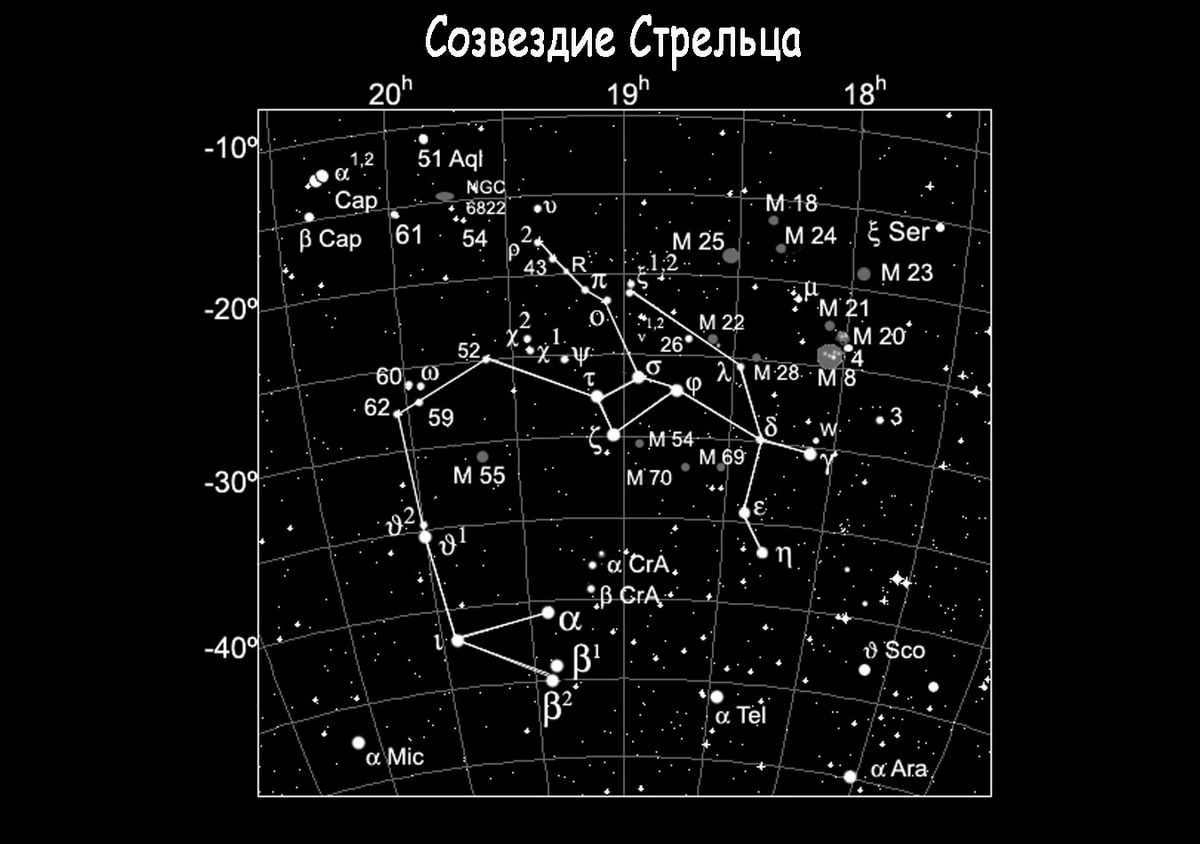
The complete configuration of Sagittarius can only be observed in the southern hemisphere of our planet. Locating it is not a difficult task. The constellation Aquila, whose tail points towards Sagittarius, can be of assistance. By tracing the path of the Milky Way from Aquila, we will eventually encounter the constellation Sagittarius. Often, the shape of Sagittarius is complemented by the presence of various passing planets. It spans an area of 867 square degrees and contains around 120 stars that have a magnitude brighter than the sixth. The overall count of stars that are part of the constellation and visible to the naked eye is 204. Among these is a navigational star known as ε Sagittarius or Kaus Aus-tralis.
Fascinating entities
The Laguna, Omega, and Triple Nebulae (Swan, Horseshoe, and Triplet) form part of the Sagittarius constellation. There are numerous dispersed and compact clusters in this region. Within the Sagittarius constellation, some notable sources emit strong radio waves, including the center of our galaxy.
Embarking on a voyage to the Omega Nebula
Traversing the Lagoon Nebula
The heart of our galaxy
Despite being the epicenter of the Milky Way galaxy, the core remains concealed from our view due to the presence of dense dust clouds. Even the most powerful telescopes are unable to penetrate this veil. However, with the aid of infrared radiation, scientists have managed to unveil the secrets hidden within this enigmatic region. It is here that a colossal cluster of stars resides, boasting a density millions of times greater than the surrounding space near our sun. These stars navigate through space at mind-boggling speeds, indicating the presence of an entity with immense mass and a small volume – a black hole. Situated an astonishing distance of 30,000 light years away, this enigmatic center continues to captivate the curiosity of astronomers worldwide.
Asterisms
Can you spot the outline of a teapot in this photo?
The asterism known as Kettle consists of the stars and constellations Askela, Kaus Meridianalis, and Kaus Australis, which form the shape of a kettle. Kaus Borealis represents the lid, Nunquit is the handle, and Alnazl is the spout. The Milky Way band itself resembles pouring water, as if the kettle is boiling.
Another small asterism is called Terebellum. It resembles a Catholic cross and consists of 4 stars.
Galaxies
NGC 6822 is an irregular dwarf galaxy located in the northeastern part of the Sagittarius constellation, approximately 1.7 million light-years away from the Sun. It was first discovered by E. Barnard in 1884. Recently, in 2002, scientists found a planet orbiting the star OGLE-TR-56, which is part of NGC 6822.
NGC 6822, also known as Barnard’s galaxy

